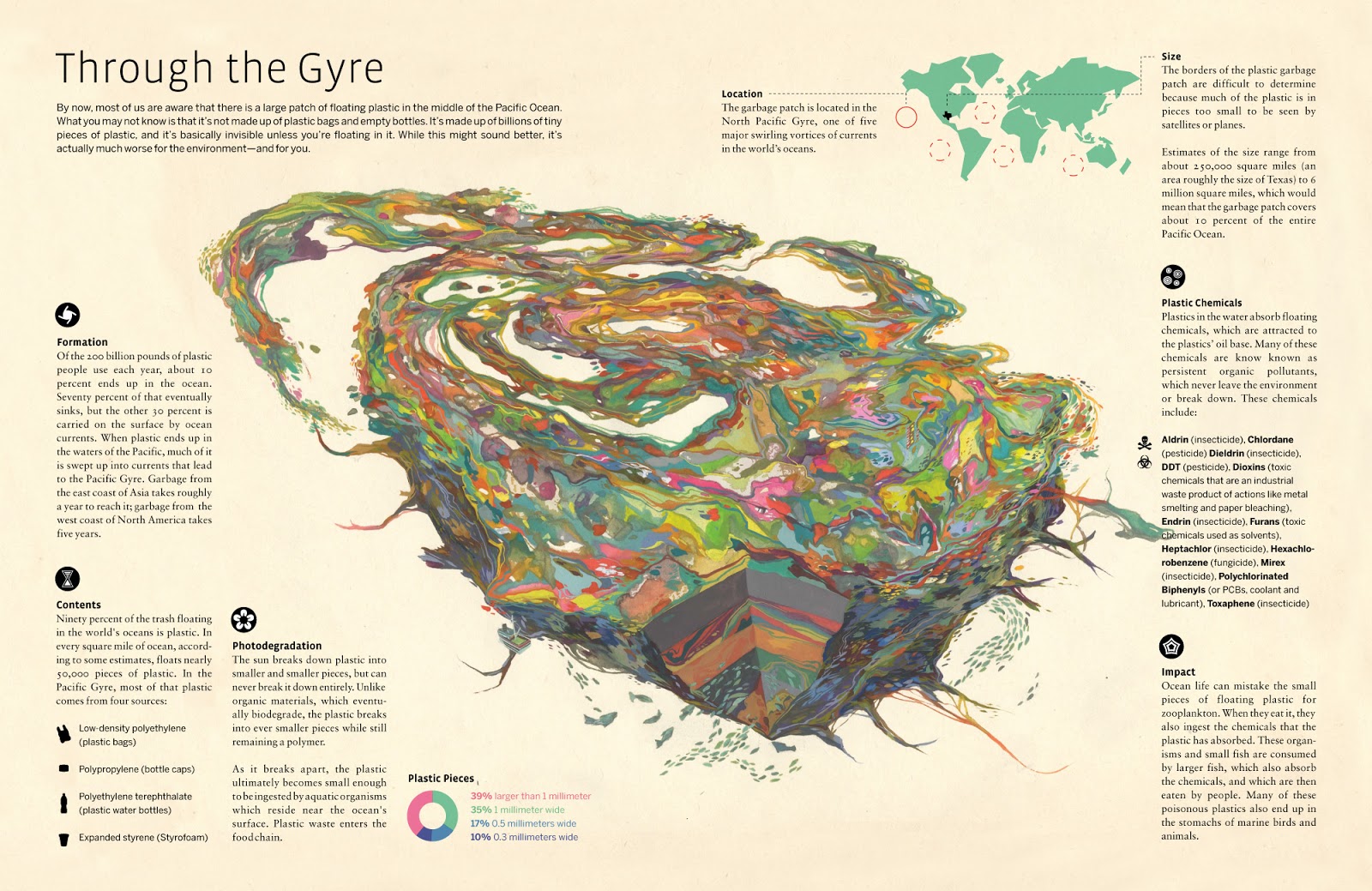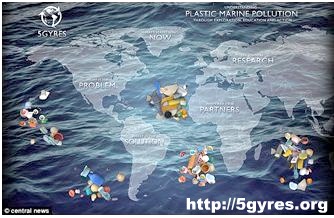Location:
The Great Pacific Garbage Patch stretches across many scales. It
is a regional and global issue. As you can see from the map created by the
NOAA, the issue is huge in the Pacific Ocean. There is a large Subtropical
Convergence Zone in which smaller Western and Eastern Garbage Patches make up
the Great Pacific Garbage Patch. Even though the issue occurs in the North
Atlantic, South Pacific and Atlantic Oceans, and Indian Ocean, we will
concentrate here, where the issue seems to be the worst by its expansive
territory. Many ecosystems are affected due to the ocean currents that move the
pollution all over the globe. This garbage is coming from coastal populations
and ship trading that crosses the Earth. Ocean currents carry this debris, as
it breaks up, until it eventually collects in these garbage patches between
currents in expansive ocean areas. This problem cannot be ignored; marine
biomes are directly affected by wildlife consumption of plastic and polluted habitats while terrestrial biomes are experiencing
the secondary effects of this pollution as beaches become littered with trash, boats get damaged, and humans eat the same wildlife that consumed this plastic.
Specifics of the problem:
 The NOAA predicted the Great Pacific
Garbage patch in a paper in the 80s. There was some evidence from plastic
measurements near Alaska, but until Charles Moore sailed through it in 1999
during a race, it had not been proven. The issue had been going on for decades
as plastics broke down and found their way here. However, it was until then
that we became conscious about the problem. Over the years, the problem had
only been getting worse and worse as global plastic consumption rose.
The NOAA predicted the Great Pacific
Garbage patch in a paper in the 80s. There was some evidence from plastic
measurements near Alaska, but until Charles Moore sailed through it in 1999
during a race, it had not been proven. The issue had been going on for decades
as plastics broke down and found their way here. However, it was until then
that we became conscious about the problem. Over the years, the problem had
only been getting worse and worse as global plastic consumption rose.
The North Pacific Gyre is at the center of the issue. It is a
collection of currents that circles the North Pacific Ocean. At the center,
there is no rapid movement of water, so objects collect at the center when they
move off the main Kuroshio or California Currents. The underlying issue is that
plastics do not break down or biodegrade naturally into the environment.
Plastics break up into smaller and smaller pieces until they are almost
invisible. They take thousands of years to biodegrade. So, not only do animals
get caught or die from the plastic, the microscopic specks that they consume
get passed up the food chain.
Toxins found throughout plastic can be found up trophic levels in
the food chain, including to humans. Thus, this issue is not one of just animal
cruelty or ecosystem pollution; it is one of human and wildlife health.
Larger Consequences:
The larger consequence of the issue
is that it is being discovered all over the world. Both the Atlantic and Indian Oceans are found to have large collections of trash at the center of gyres. These plastic, not biodegradable particles are being distributed in expansive piles throughout the world’s
oceans. Marine wildlife is dying and habitat is being destroyed not only in the
Pacific Ocean, but also the Atlantic and Indian Oceans. The global consequence is the destruction of our marine ecosystems all over the world. The effects that we have on just this marine ecosystem will effect all others by how ecosystems are linked. The
pollution of toxins into the marine food chain is not only damaging to wildlife health, but also our own. Below,
there is figure made by the ClimateDesk.org that shows the worlds biggest plastic
polluters. This shows that the source of the problem is not stopping or slowing
down. The large consequence of the issue is that this will be a global problem
for years to come with developing countries like China and Indonesia polluting at massive rates. Steps are being made to identify and solve this problem, but the source of the pollution is not slowing down anytime soon in certain countries. Plastic will continue to pile up in the Great Pacific Garbage Patch for many years.
Solutions:
The first solutions seem to be very
obvious. If we recycle more and cut down on plastic use, there will be less
plastic going into the ocean. These tend to be very successful on small,
regional scales, as seen in cities like Los Angeles. However, this will not fix the global problem with China and Indonesia polluting more than ever right across the Pacific. On that scale, legal
and international policies will need to be implemented to see real change. In
1975, the London Convention attempted to set the framework for regulation of
deliberate disposal in oceans. This was the first step in major international ocean pollution policy. The US Marine Protection, Research, and
Sanctuaries Act of 1972 did a lot to save ecosystems in the US. However, the US
Marine, Debris, Research, Prevention, and Reduction Act of 2006 is the policy
that really took crucial steps to identify, locate, and fix marine debris
pollution. It was one of the first times that a major developed, yet polluting country attempted to prevent plastic pollution and clean it up. These policies have seen success, but mostly with developed nations and especially, the US. In these countries, the science and funding have the ability to identify and solve the issue. They have an incentive. However, developing nations have not addressed
the issue and continue to pollute plastic at very high rates. There is no real international policy to research, prevent, and
fix this problem. Thus, it is only with the help of recycling and reducing plastic locally that international policy could possibly finish solving the problem. It would work on a global scale, rather than regional. However, that is just the issue. The possibility of executing real international policy is small due to the decisions of developing countries.
Conclusion:
If the Great Pacific
Garbage Patch, as well as all the others, will ever be cleaned up and resolved,
the international world will need to take great steps in international policy.
We can do all we can locally to recycle and reduce plastic use, but this needs
to be done with successful international policy. The likelihood of all this is
very slim; however, it can be done. The over-arching lesson is that this must
be resolved. Marine wildlife will continue to die and eat toxins. These toxins
will continue to move up the food chain to us. The very long-term effects of
this issue have yet to be seen, but they are there. Humans must begin to act
and protect the marine ecosystem before we change it to the point of no return.
Reference List:
Sources:
Dautel, Susan. "Transoceanic Trash: International and
United States Strategies For the Great Pacific Garbage Patch." Golden
Gate University Environmental Law Journal 3.8 (2010): n. pag.Digitalcommons.law.ggu.edu.
Golden Gate University, 12 Aug. 2010. Web. 5 Mar. 2015.
"Great Pacific Garbage Patch." National
Geographic Education. National Geographic Society, 2015. Web. 11 Feb. 2015.
Hoshaw, Lindsay. "Afloat in the Ocean, Expanding Islands
of Trash." The New York Times (2009): n. pag. Greenrock.org.
Greenrock.org, 10 Nov. 2010. Web. 5 Mar. 2015.
Silverman, Jacob. "Why Is the World's Biggest Landfill
in the Pacific Ocean?" Discovery (2013): n. pag. Davincisschools.org.
Da Vinci Schools, 12 Dec. 2013. Web. 5 Mar. 2015.
Map:
"Great Pacific Garbage Patch." National
Geographic Education. National Geographic Society, 2015. Web. 11 Feb. 2015.
Table:
http://climatedesk.org/2015/02/theres-a-horrifying-amount-of-plastic-in-the-ocean-this-chart-shows-whos-to-blame/
Images:







No comments:
Post a Comment